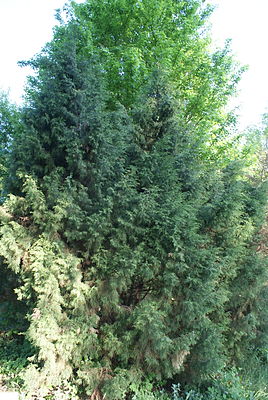Hemispherical juniper
| Hemispherical juniper | ||||||||||||
|---|---|---|---|---|---|---|---|---|---|---|---|---|

Hemispherical juniper ( Juniperus semiglobosa ) |
||||||||||||
| Systematics | ||||||||||||
|
||||||||||||
| Scientific name | ||||||||||||
| Juniperus semiglobosa | ||||||||||||
| rule |
The Hemispherical juniper ( Juniperus semiglobosa ) is a plant from the family of the cypress family (Cupressaceae). It is native to the mountains of Central Asia.
description
Appearance and bark
The hemispherical juniper grows as an evergreen , mostly single-stemmed tree , occasionally also as a shrub , which can reach heights of growth of 10 to 20 meters and diameters of 1 to 2 meters at chest height . The dense but occasionally open crown is broadly pyramidal to irregular in shape. The long first-order branches on both young and old trees go straight or ascending from the trunk, while the dense, higher-order branches on young trees are straight or ascending and hanging from older trees. The branches have a round or approximately square cross-section.
Young trees have a smooth, reddish-brown bark from which gray, paper-like flakes peel off after a short time. The fibrous and longitudinally cracked bark of older trees is reddish-brown to gray-brown in color and flakes off in long strips. The bark of the older branches is slightly purple in color and covered with gray flakes.
Foliage
The hemispherical juniper has heterophyllia . The needle-shaped and stinging leaves are alternate on the branches and are 8 to 10 millimeters long and about 1 millimeter wide. They are mainly found on seedlings and the lower branches of mature trees. On older trees there are mainly scale leaves, which are diamond-shaped to triangular in shape on the upper branches with a length of 1 to 2 millimeters. On older branches they are up to 9 millimeters long and are lanceolate to inverted-lanceolate in shape. All scale leaves are light green to yellowish green in color and shine because they are covered by a thick layer of wax . Its tip is pointed and the leaf margins are entire. On the underside of the leaf there are two inconspicuous stomatal lines . The noticeable glands are elliptical in shape.
Cones and seeds
The 3 to 5 millimeters long and 2 to 4 millimeters thick male cones are initially green and later turn yellow. They contain eight to ten shield-shaped microsporophylls which each carry three to four pollen sacs . The stemless female berry cones are 4 to 6 millimeters long and 4 to 8 millimeters thick and are approximately spherical to triangular, but mostly irregular and only rarely spherical in shape. Initially they are dark green in color and turn light brown to black-blue as they mature and are often frosted. Each of the fleshy cones consists of four to six fused seed scales and their interior is yellowish green. Each cone bears one to four yellow to reddish brown seeds. The seeds are 3 to 6 millimeters long and 2 to 4.5 millimeters wide, more or less egg-shaped or conical in shape.
Occurrence, site conditions and exposure
The natural range of the hemispherical juniper is in the mountainous regions of Central Asia . It extends there from Uzbekistan and southern Kazakhstan in the west through Kyrgyzstan , Tajikistan and the Hindu Kush in northeast Afghanistan along the Karakoram to Pakistan, Kashmir and northern India in the east. In India it extends along the Himalayas to Garhwal . There is also an occurrence in the Kunlun Mountains in China.
The hemispherical juniper thrives at altitudes of 1600 to 4300 meters. It occurs there mainly in semi-arid high valleys on rocky soils, moraines , on stony slopes or in crevices. In some locations, the annual precipitation is below 400 mm, a large part of which falls as snow . The species can develop pure stands in the entire distribution area. Especially in Afghanistan and the Pamir as well as the Tian Shan the hemispherical juniper forms mixed stands with the Persian juniper ( Juniperus polycarpos ) and Juniperus pseudosabina . In more humid areas there are mixed stands of birch ( Betula ), poplar ( Populus ) and whitebeam ( Sorbus ). In the western Himalayas, other coniferous trees continue to develop, especially the Himalayan cedar ( Cedrus deodara ).
The hemispherical juniper is classified as "not endangered" in the IUCN Red List . It is pointed out, however, that a new review of the hazard is necessary.
Systematics
The first description as Juniperus semiglobosa was made in 1879 by Eduard August von Regel in Trudy Imperatorskago S. Peterburgskago Botaničeskago Sada , Volume 6 (2), page 487. synonyms for Juniperus semiglobosa usually are Juniperus schug anica Kom. , Juniperus tianshanica Sumnev. , Sabina semiglobosa (rule) LKFu & YFYu and Juniperus sabina var. Jarkendensis (Kom.) Silba .
use
The wood of the hemispherical juniper is used as firewood and furniture wood.
swell
- Christopher J. Earle: Juniperus semiglobosa. In: The Gymnosperm Database. www.conifers.org, November 28, 2012, accessed January 1, 2013 .
- Liguo Fu, Yong-fu Yu, Robert P. Adams & Aljos Farjon: Cupressaceae . Juniperus. In: Wu Zhengyi, Peter H. Raven & Hong Deyuan (eds.): Flora of China . Cycadaceae through Fagaceae. Volume 4. Science Press and Missouri Botanical Garden Press, Beijing and St. Louis 1999, ISBN 0-915279-70-3 , Juniperus semiglobosa , pp. 75 (English, Juniperus semiglobosa - online - this printed work is online with the same text).
Individual evidence
- ↑ a b c d e f Christopher J. Earle: Juniperus semiglobosa. In: The Gymnosperm Database. www.conifers.org, November 28, 2012, accessed January 1, 2013 .
- ↑ Juniperus semiglobosa in the endangered Red List species the IUCN 2012. Posted by: Conifer Specialist Group, 1998. Retrieved on January 1, 2013.
- ↑ Juniperus semiglobosa at Tropicos.org. Missouri Botanical Garden, St. Louis, accessed January 1, 2013.
- ↑ a b Juniperus semiglobosa. In: Germplasm Resources Information Network. www.ars-grin.gov, accessed on January 1, 2013 (English).